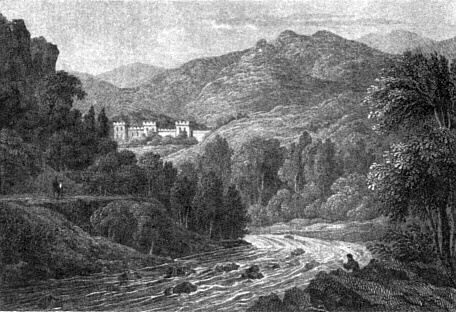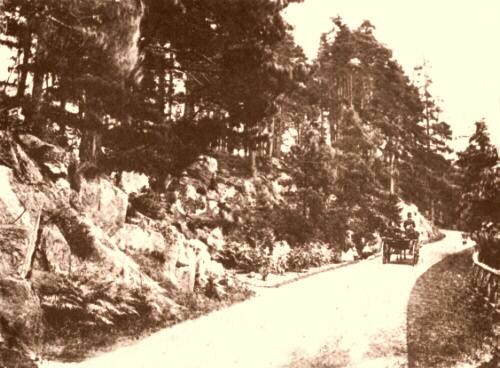
| The earliest history regarding the lands of and Bonskeid told how Robert the Bruce came that way when a fugitive after his defeat at the battle of Methven, 1306. He was hiding on the land between the Tummel and Garry and was given refuge and Athol Brose for refreshment. A tablet on the end of the ruined house of old Coillebhrochain records this and also in its Gaelic name of Coillebhrochain (the wood of the brose). |
| About 160 years after this, in 1474, these lands together with those of Bonskeid and Borenich were granted to one of the Stewarts of Garth - a great grandson of the noted "Wolf of Badenoch", himself a great grandson of Robert the Bruce. These lands are still held by a descenent in the female line of this Alexander Stewart. The old house of Bonskeid stood high up, where the Mains of Bonskeid now stands, and a stone from the old house is built into the wall bearing the inscription J.S. AO, 1688. This house was burnt down in the eighteenth century and the ownder, John Stewert, could not afford to rebuild it. His wife, a Stewart of Fincastle, died young, and he himself was accidentally killed in a brawl. His young son, Alexander, 1753-1835, studied at Edinburgh University and went as a surgeon with the Scots contingent to the Army of the prince of Orange in Holland, later becoming the doctor at Dunkeld. From there he used to ride up to Bonskeid to look after his property and a room was kept for him at Old Coillebhrochain as he had no house of his own. He was a friend of the Duke of Atholl who gave him some of the seed of the original larch trees introduced into Scotland, one of which is still standing in front of the house at Bonskeid, and is known as the "Stewart Larch". |
| In 1796 Dr Stewart gave a lease of the lands at Bonskeid to Lady Bath and her husband Sir James Pulteney to "build a house in the Birchwood above the Tummel". Building of stables and coach houses began on the site of the present house, while Lady Bath lived in a tent near Coillebhrochain till she unexpectedly died. Sir james had the stables made into a shooting lodge, the coach houses becoming the public rooms and battlements surmounting the front. This still stands as part of the house extending from the kitchen to the front door. But before Sir James could use the house he died in a gun accident, so the house and its contents came to Dr Stewart according to the terms of the lease. In 1811 Dr and Mrs Stewart took possession of the new house. Their only child Margaret married Glas Sandeman of Perth and, on the death of her father, she succeeded to Bonskeid and was known as Mrs Stwart Sandeman. In her day the front door was on the north side of the house and on the south side was a french window opening into the drawing room (the present front hall). She built Fincastle Chapel in 1844. |

| She had a daughter Margaret who married George Freeland Barbour and he bought the property from her to keep it in his wife's family. He then enlarged and altered the house and finished it in 1869. A new front door and steps were built on to the then dining room, and the large high part added at the west end, all in "Scottish baronial" style. He also made roads and drives to the West Lodge and to the Falls, and paths round the West Wood and to the river. He built the West Lodge in memory of Mrs Barbour's mother, Mrs Stewart Sandeman. |

| George F. Barbour died in 1887, but his wife continued to live at Bonskeid. Their son Robert added Fincastle to the property and lived there till his early death in 1891. His wife Charlotte Barbour managed the estate till 1903 during the minority of her son, another George Freeland Barbour. She did a lot to improve the house and built the billiard room, and made great improvements in the kitchen and back parts of the house. In 1908 the stables were rebuilt and in the first World War the house was used as a Red Cross hospital. |
| In 1921 G. F. Barbour decided the house was too big for private use and he let it to the Y.M.C.A. as a Conference Centre. After a year's trial, a lease was arranged and the house was largely cleared of family furniture and pictures. Though most of the family treasures have been removed from Bonskeid, there are still several portraits and busts in the public rooms to remind visitors of the Bonskeid of yester year.... |
| In the second World War the Y.M.C.A. let the house to the Glasgow Girls' High School, then to the Polish authorities as a Convalescent Home, and finally to the Perth County Council for evacuee children. At the end of the War the Y.M.C.A. took over again, and finally bought the house from the Rev. Robert A. S. Barbour in 1951. The Y.M.C.A added the bungalow and the new dining room and made alterations in the stables court providing many more single bedrooms. A major refurbishment programme was carried out in 1993, which included central heating to all rooms. |
| Verbatim copy, less room details and tree details, of a free once paper available at Bonskeid House. |
Adrian Worsfold